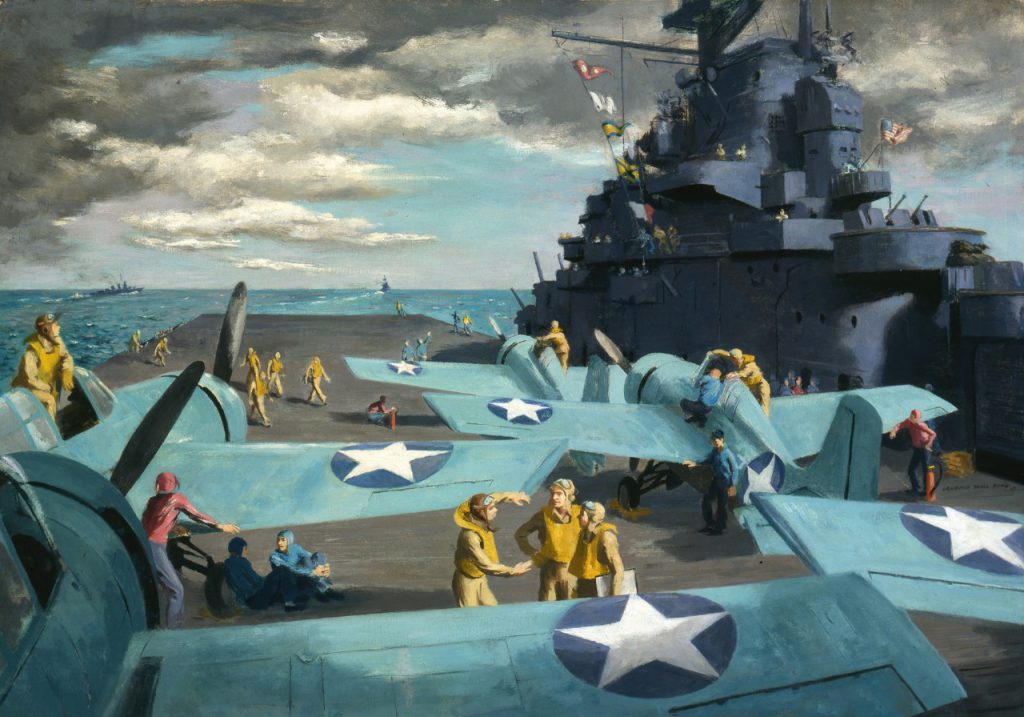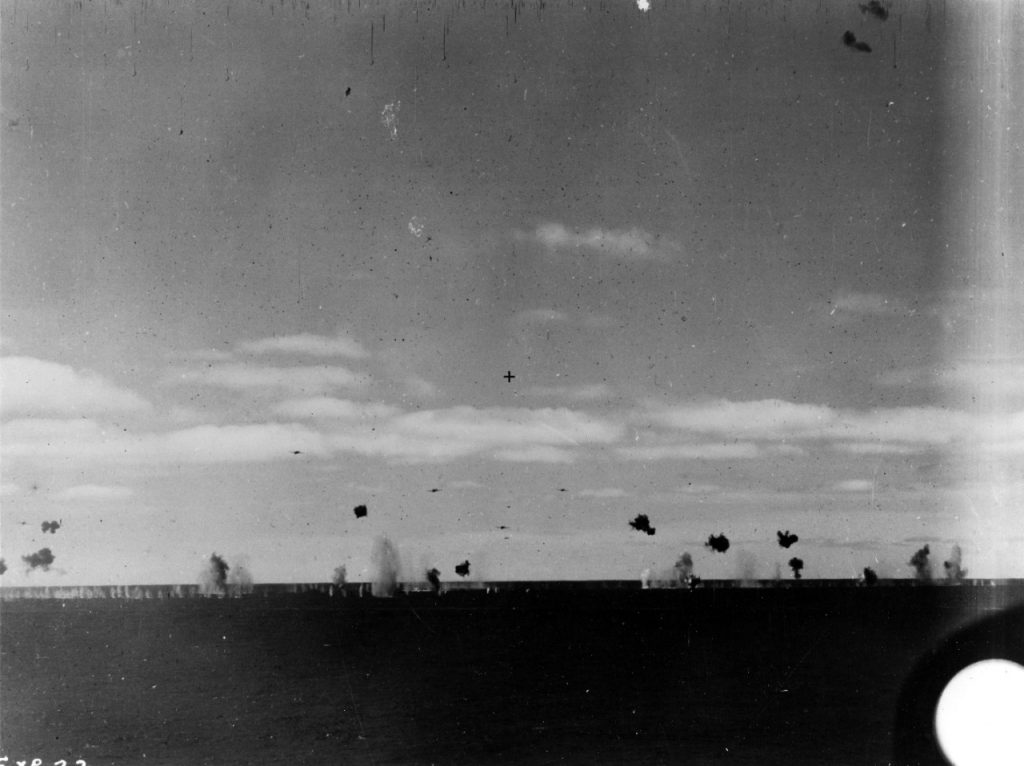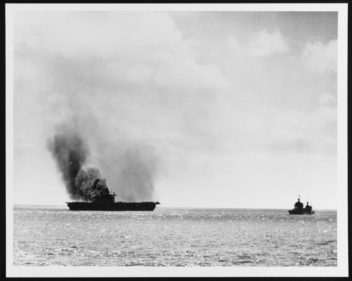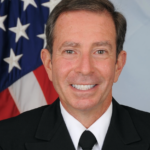The Battle of Midway Still Teaches the Value of Intelligence, Decisive Action
Editor’s Note: this essay from Paul Becker sums up some of the lessons that we have already paid for in blood and treasure, and which we need to re-learn. Our thanks to the Navy’s History and Heritage Command, ably led by RADM Sam Cox, for publishing this in The Sextant. http://usnhistory.navylive.dodlive.mil/
75 years ago today the loss of Vice Admiral Nagumo’s four fleet carriers, Admiral Yamamoto realised that his Midway offensive had become a fiasco. He believed that he could still save face by concentrating his battleships and cruisers and launching night attacks on the Midway military installations and the two surviving American carriers and their warship escorts.
The advantage in night actions would lie with the Japanese who had developed a high degree of technical skill in night fighting at sea, and Yamamoto was aware that the American carriers would be hampered by the difficulty of launching and recovering aircraft at night.
However, Rear Admiral Spruance had foreseen the possibility of a night attack on his carriers by Japanese warships, and had temporarily withdrawn his ships to the east. Shortly after midnight, on 5 June, when there was no longer a question of a night action, Spruance turned back in the hope of closing with the Japanese warships in time for a daylight air strike.
– Vic
The Battle of Midway Still Teaches the Value of Intelligence, Decisive Action
– June 2, 2017 Posted in: Heritage, Heritage Headlines, Naval Operations, Our People, Platforms, Ships, Uncategorized

(Painting, Oil On Board; by Lawrence Beall Smith; 1943. Currently on loan to the Pacific Aviation Museum on Ford Island from it’s original location in the base theater at Midway Atoll).
By Rear Admiral Paul Becker, USN (Ret)
June 4 marks the 75th anniversary of the Battle of Midway, the greatest naval battle in American history and the turning point of World War II in the Pacific. At Midway, a larger Japanese fleet was surprised and defeated by smaller, less combat-experienced U.S. naval forces. Victory was enabled by superb intelligence, advanced by sound decision-making, and assured by skill, courage, and sacrifice. Its lessons for war planning, war fighting, and war winning are as applicable today as they were in 1942.
At the outbreak of World War II, the Japanese Navy seemed unstoppable. U.S. military forces were down following Pearl Harbor and a Philippines surrender, but demonstrated they were not out when Lt. Col. James “Jimmy” Doolittle’s B-25 bombers conducted a raid on Tokyo in April 1942. Japan’s Fleet Commander, Adm. Isoroku Yamamoto, erroneously reasoned Doolittle flew from Midway Island, 1,500 miles west of Hawaii. He never considered the raid was launched from USS HORNET at Naval Air Station Alameda, California. Yamamoto, for revenge, wanted to attack Midway with a four carrier task force, believing he could lure and defeat the U.S. Navy’s three central Pacific carriers in a decisive engagement.
U.S. Pacific Fleet Commander Adm. Chester Nimitz placed full trust in his intelligence team following its accurate predictions of Japanese actions at the Battle of the Coral Sea the month prior. The leaders of this team were Cmdr. Joseph Rochefort – the Officer in Charge of Station Hypo, a communications center in the basement of Pearl Harbor headquarters packed with cryptologists, linguists, translators and all-source intelligence analysts – and Cmdr. Edwin Layton, the Pacific Fleet Director of Intelligence (N2). Also on Layton’s staff was Lt. Jasper Holmes, who devised a plan to pass false information announcing Midway was having trouble distilling water as a ruse to confirm a vital information gap. The belief that the Japanese were referring to Midway as “AF” was confirmed when a subsequent Japanese transmission relayed, “AF is short on water.”

Japanese Nakajima Type 97 shipboard attack aircraft from the carrier Hiryu fly through anti-aircraft shell bursts while approaching USS Yorktown (CV-5) to deliver a torpedo attack, during the mid-afternoon of 4 June 1942.
When pressed for specifics on Japanese intent at Midway, Layton declared to Nimitz the attack would occur on the morning of June 4 from the northwest on a bearing of 325 degrees, 175 miles from Midway at 0600. Nimitz directed his Task Force commanders to employ their limited forces to inflict maximum damage on the Japanese fleet based upon this intelligence estimate and delegated specific battle plans to them. At dawn on June 4, U.S. scout planes located the Japanese fleet, after which Nimitz remarked to his N2, “Well you were only five miles, five degrees and five minutes off!”
Initial air strikes by Midway-based Navy, Marine Corps, and U.S. Army Air Force planes against Japanese ships were unsuccessful and at great cost, but significantly disrupted Japanese decision-making and operations. Torpedo planes were the first carrier-based aircraft to make runs at four Japanese carriers. Despite their devotion to mission, none of their weapons impacted a Japanese ship. However, they likely diverted Japanese defenses just in time for dozens of U.S. carrier-based dive-bombers to arrive when the Japanese carriers were most vulnerable while refueling and rearming their planes. Within the span of several minutes, American bombs tore into four Japanese carriers and all were eventually sunk, along with more than 300 aircraft and three thousand sailors and aviators. By comparison, the U.S. only lost one aircraft carrier, Yorktown, and several hundred sailors and aviators.

Heavy smoke rolls from stack of the USS Yorktown after the aircraft carrier was damaged heavily by Japanese aircraft June 4 in The Battle of Midway
After Midway, the Japanese lost their aura of invincibility and the ability to effectively maintain the offensive. There were many random events and miscues that occurred during Midway that some attribute to luck. I’ve found such occurrences are commonplace in battle. What cannot be attributed to luck – when preparation met opportunity – was the tireless effort to break Japanese code and deliver all-source, operational intelligence (OPINTEL) that provided U.S. decision advantage. According to Ens. Mac Showers, who would later rise to the rank of Rear Admiral and was the last surviving member of Layton’s Pacific Fleet Intelligence Staff until his passing in 2012, “This was the origin of OPINTEL. No such systems existed prior to Pearl Harbor. No one told us to do it, or how to do it. Rochefort had the concept, Layton masterminded the execution, and Holmes was the genius who made it all work.”
A few more thoughts on the enormity of the task facing Station Hypo. Overall comprehension of the Japanese Naval code in 1942 was only 10-15 percent of the incredible quantity of messages being sent. It was Station Hypo’s equivalent of what today would be called “sifting through big data.” So how was it that simply reading a fraction of Japanese traffic allowed the team to predict Midway was the next target? That answer is found in the tireless dedication, genius, and collaboration of Rochefort and Layton. The two demonstrated an absolute mastery of knowledge of Japan and their Navy due to years of intensive study of this adversary, which included living, studying, and working in Japan in the late 1920s and 1930s. Their success wasn’t simply predicated upon a technical understanding of code, but equally dependent upon knowledge of Japanese language and culture and familiarity with the Admirals who were leading the Japanese fleet. This supreme all-source, deep penetrating understanding of the enemy provided Adm. Nimitz the decision advantage he needed to boldly risk engaging the enemy with the crown jewels of his fleet: his only operational aircraft carriers.
This leads to examination of current U.S. national security threats and how our Intelligence Community conducts operations in today’s combustible global environment. Providing meaningful intelligence to war-fighters and decision-makers involves much more than just the ability to collect and transfer large amounts of data regarding military, commercial, social, and economic networks. It also requires an equally deep, penetrative understanding of our potential adversaries’ strategies, mindsets, and intent. A firm grasp of adversary strategic goals is essential for shaping policy and war plans: If one doesn’t understand an adversary’s strategy, then one might think the adversary is conducting random acts; and to counter those random acts, we would ourselves conduct random responses.
When it comes to understanding threats today, our Intelligence Community faces a data glut and information deficit. How many of our analysts understand Chinese, Russian, Iranian, or North Korean threats on a strategic level that includes language, culture, history, personalities, goals, and calculations to a level that Rochefort and Layton understood the Japanese 75 years ago? Focusing on just China, for example: How many intelligence professionals involved in OPINTEL or planning in the Pacific Theater or Intelligence Community have studied in China or at least are fluent with the language? How many understand the end states of the Chinese Communist Party’s Grand Strategy for Rejuvenation by the Year 2050? What are Chinese interim objectives between now and then? What does the Central Military Commission mean when they talk about “harmonious seas?’
Ensuring a deep penetration of the enemy by our Intelligence Community is not just needed to prepare to win potential conflicts, but more importantly, to think one step ahead of our adversaries and hopefully avoid conflicts. In closing, it’s worth citing one of the greatest contributors to victory at Midway, Capt. Rochefort: “I have often said that an intelligence officer has one task, one job, one mission. This is to tell his commander, his superior today, what the [enemies] are going to do tomorrow. This is his job. If he doesn’t do this, then he’s failed.”

About the author: Rear Admiral Paul Becker, USN (Ret) served 30 years in peace, crisis and combat as a Naval Intelligence Officer. He most recently led the Presidential Transition’s Intelligence Community Landing Team. His Flag Officer assignments include: Director of Intelligence (J2) for the Joint Chiefs of Staff, the U.S. Pacific Command in Hawaii, and International Security Assistance Force Joint Command in Afghanistan. Paul holds an MPA from Harvard’s Kennedy School of Government and a BS from the U.S. Naval Academy. He is a Senior Fellow with the Center for Naval Analyses and Professor of Practice at the University of Virginia’s Batten School for Leadership and Public Policy. The Naval Intelligence Community recognized RADM Becker in 2016 by establishing a “Teamwork, Tone, Tenacity” leadership award named in his honor.
